ECF402 Child Development Portfolio: Theories and Practitioner Role
VerifiedAdded on 2023/06/08
|16
|3888
|200
Portfolio
AI Summary
This portfolio provides an overview of child development, emphasizing the importance of understanding developmental milestones and theories for practitioners. It discusses brain development, highlighting the significance of early experiences and supportive environments in shaping neural connections. Piaget’s cognitive developmental theory is explored, with a focus on the sensorimotor and preoperational stages, and how practitioners can apply these concepts in their practice to support children's learning and growth. The portfolio concludes by reflecting on the key learnings and insights gained throughout the study of child development. Desklib provides past papers and solved assignments for students.
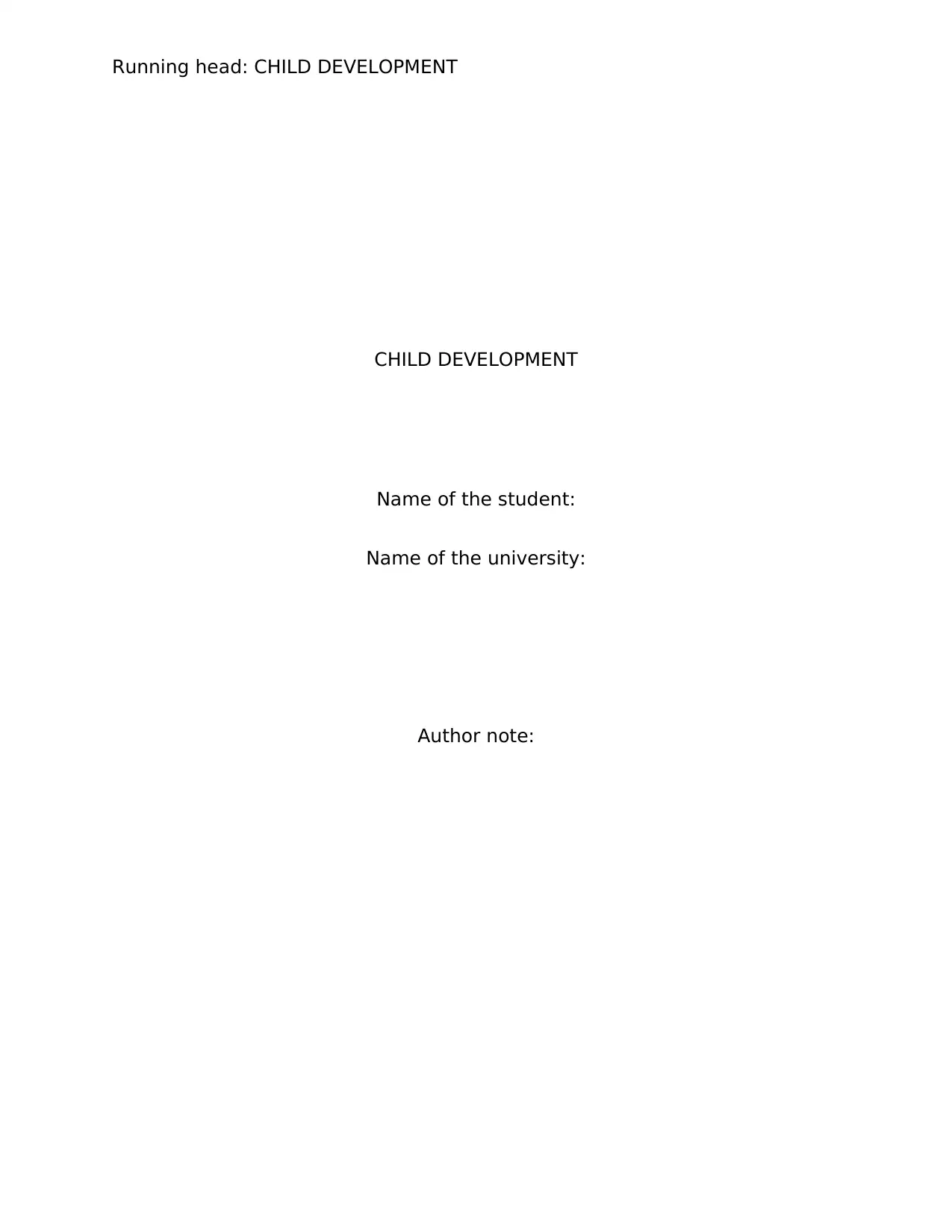
Running head: CHILD DEVELOPMENT
CHILD DEVELOPMENT
Name of the student:
Name of the university:
Author note:
CHILD DEVELOPMENT
Name of the student:
Name of the university:
Author note:
Paraphrase This Document
Need a fresh take? Get an instant paraphrase of this document with our AI Paraphraser
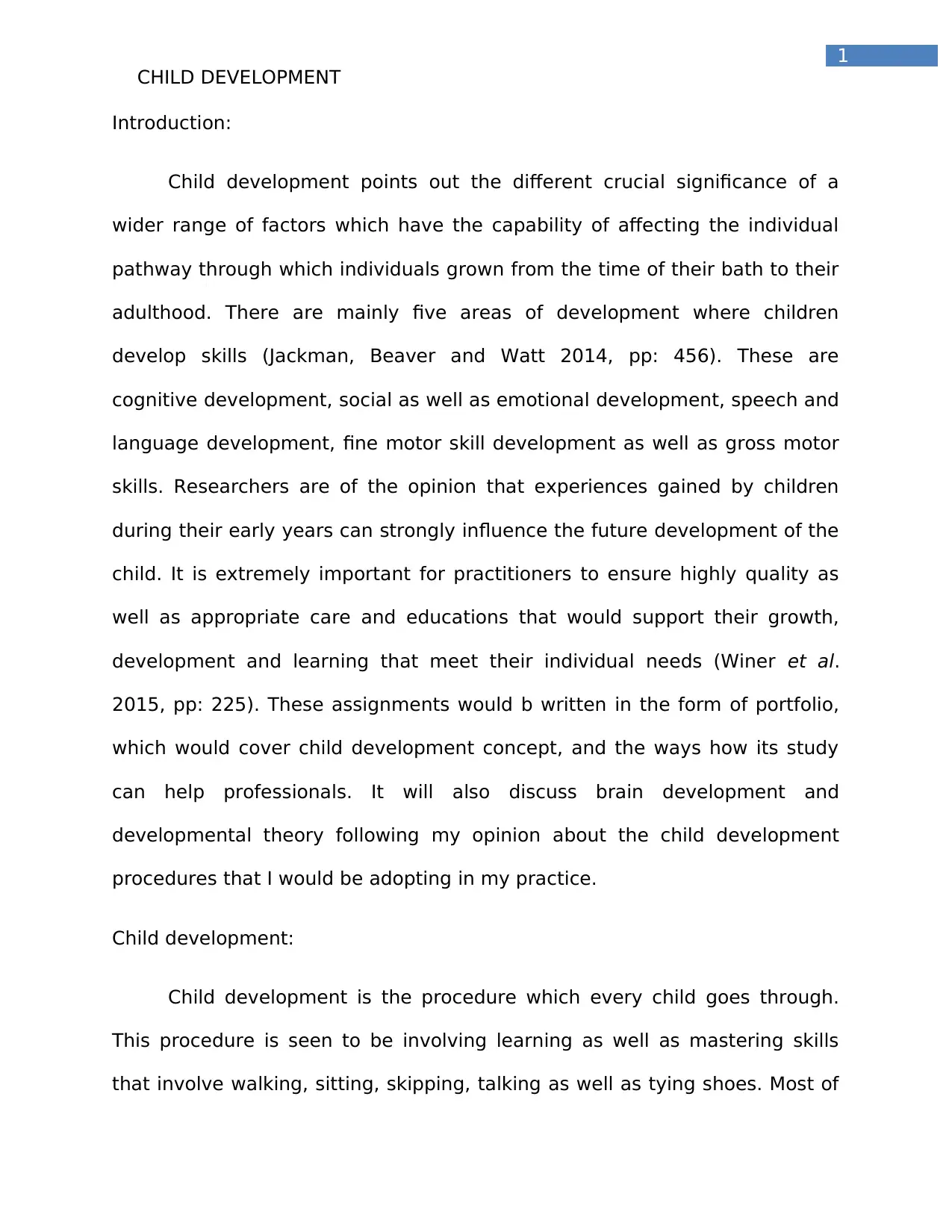
1
CHILD DEVELOPMENT
Introduction:
Child development points out the different crucial significance of a
wider range of factors which have the capability of affecting the individual
pathway through which individuals grown from the time of their bath to their
adulthood. There are mainly five areas of development where children
develop skills (Jackman, Beaver and Watt 2014, pp: 456). These are
cognitive development, social as well as emotional development, speech and
language development, fine motor skill development as well as gross motor
skills. Researchers are of the opinion that experiences gained by children
during their early years can strongly influence the future development of the
child. It is extremely important for practitioners to ensure highly quality as
well as appropriate care and educations that would support their growth,
development and learning that meet their individual needs (Winer et al.
2015, pp: 225). These assignments would b written in the form of portfolio,
which would cover child development concept, and the ways how its study
can help professionals. It will also discuss brain development and
developmental theory following my opinion about the child development
procedures that I would be adopting in my practice.
Child development:
Child development is the procedure which every child goes through.
This procedure is seen to be involving learning as well as mastering skills
that involve walking, sitting, skipping, talking as well as tying shoes. Most of
CHILD DEVELOPMENT
Introduction:
Child development points out the different crucial significance of a
wider range of factors which have the capability of affecting the individual
pathway through which individuals grown from the time of their bath to their
adulthood. There are mainly five areas of development where children
develop skills (Jackman, Beaver and Watt 2014, pp: 456). These are
cognitive development, social as well as emotional development, speech and
language development, fine motor skill development as well as gross motor
skills. Researchers are of the opinion that experiences gained by children
during their early years can strongly influence the future development of the
child. It is extremely important for practitioners to ensure highly quality as
well as appropriate care and educations that would support their growth,
development and learning that meet their individual needs (Winer et al.
2015, pp: 225). These assignments would b written in the form of portfolio,
which would cover child development concept, and the ways how its study
can help professionals. It will also discuss brain development and
developmental theory following my opinion about the child development
procedures that I would be adopting in my practice.
Child development:
Child development is the procedure which every child goes through.
This procedure is seen to be involving learning as well as mastering skills
that involve walking, sitting, skipping, talking as well as tying shoes. Most of
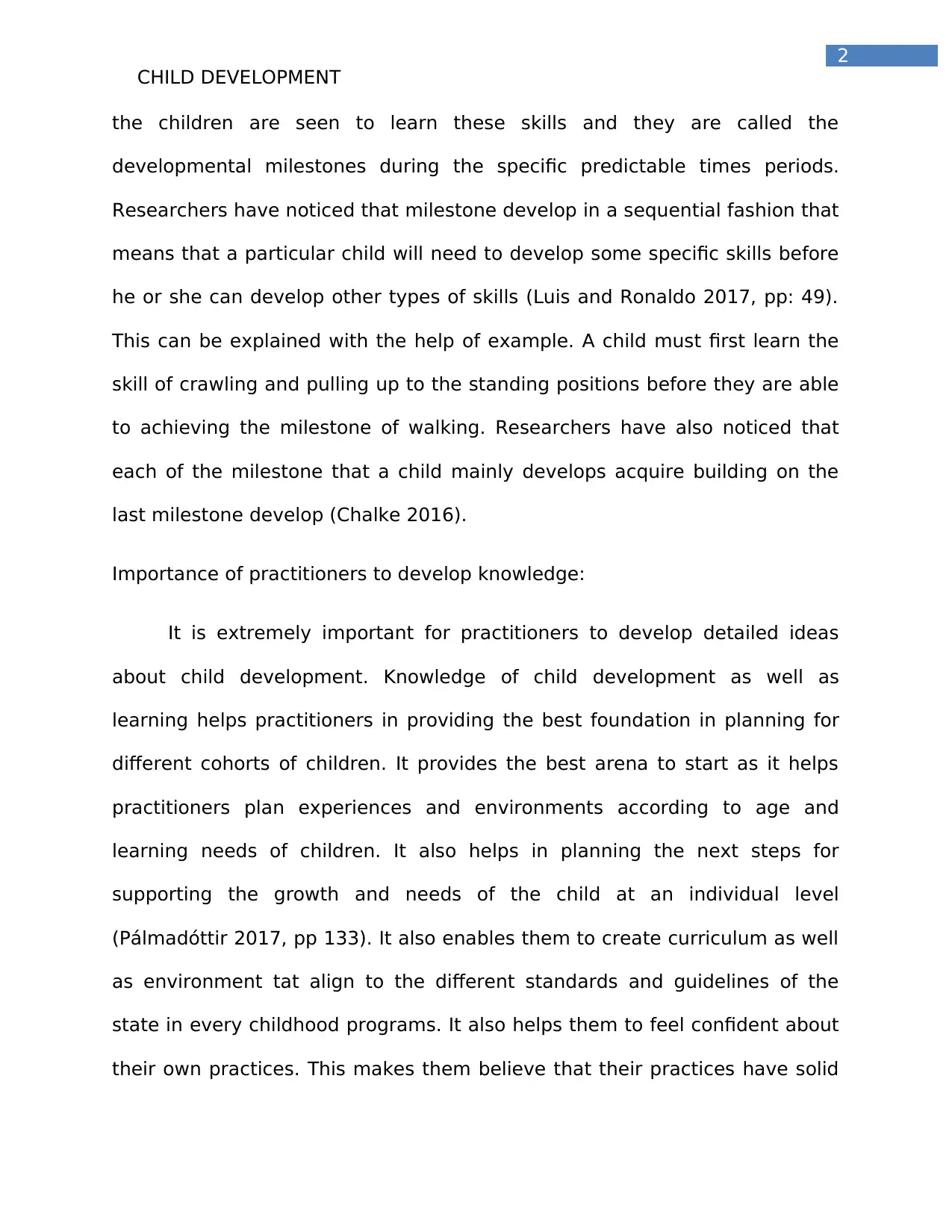
2
CHILD DEVELOPMENT
the children are seen to learn these skills and they are called the
developmental milestones during the specific predictable times periods.
Researchers have noticed that milestone develop in a sequential fashion that
means that a particular child will need to develop some specific skills before
he or she can develop other types of skills (Luis and Ronaldo 2017, pp: 49).
This can be explained with the help of example. A child must first learn the
skill of crawling and pulling up to the standing positions before they are able
to achieving the milestone of walking. Researchers have also noticed that
each of the milestone that a child mainly develops acquire building on the
last milestone develop (Chalke 2016).
Importance of practitioners to develop knowledge:
It is extremely important for practitioners to develop detailed ideas
about child development. Knowledge of child development as well as
learning helps practitioners in providing the best foundation in planning for
different cohorts of children. It provides the best arena to start as it helps
practitioners plan experiences and environments according to age and
learning needs of children. It also helps in planning the next steps for
supporting the growth and needs of the child at an individual level
(Pálmadóttir 2017, pp 133). It also enables them to create curriculum as well
as environment tat align to the different standards and guidelines of the
state in every childhood programs. It also helps them to feel confident about
their own practices. This makes them believe that their practices have solid
CHILD DEVELOPMENT
the children are seen to learn these skills and they are called the
developmental milestones during the specific predictable times periods.
Researchers have noticed that milestone develop in a sequential fashion that
means that a particular child will need to develop some specific skills before
he or she can develop other types of skills (Luis and Ronaldo 2017, pp: 49).
This can be explained with the help of example. A child must first learn the
skill of crawling and pulling up to the standing positions before they are able
to achieving the milestone of walking. Researchers have also noticed that
each of the milestone that a child mainly develops acquire building on the
last milestone develop (Chalke 2016).
Importance of practitioners to develop knowledge:
It is extremely important for practitioners to develop detailed ideas
about child development. Knowledge of child development as well as
learning helps practitioners in providing the best foundation in planning for
different cohorts of children. It provides the best arena to start as it helps
practitioners plan experiences and environments according to age and
learning needs of children. It also helps in planning the next steps for
supporting the growth and needs of the child at an individual level
(Pálmadóttir 2017, pp 133). It also enables them to create curriculum as well
as environment tat align to the different standards and guidelines of the
state in every childhood programs. It also helps them to feel confident about
their own practices. This makes them believe that their practices have solid
⊘ This is a preview!⊘
Do you want full access?
Subscribe today to unlock all pages.

Trusted by 1+ million students worldwide

3
CHILD DEVELOPMENT
basis that align with the larger childcare professional community. Specific
knowledge of each age of child development helps them to realize that child
is lacking in capabilities and require special guidance (Churches, Halls and
Higgins 2017, pp: 556).
The ways the brain develops:
Starting from the last trimester of the prenatal period, pathways of the
brain starts forming by the development of new connections. At birth,
newborns are seen to start with very similar brain as well as brain structures.
These are the followed by the sensitive periods during the development of
the brain of the child when the wiring of the brain for specific abilities is
established. Researchers are of the opinion that providing nurturing;
responsive as well as stimulating experiences mainly help in establishing the
wiring of the brain connections (Szilagayi 2018: pp 21). Children who are well
supported as well as nurtured emotionally, socially, physically as well as
intellectually tend to develop multitude of neural connections. These mainly
help them to serve throughout the life courses. The interest and the curiosity
of the child act as the main motivators. These help in creating new
connections in the brain for the acquiring of the new skills. It is seen hat each
of the new skills of the child are based on the skills which are already
developed and learned (Zollo 2017, pp: 55). The environment of the child
mainly helps in supporting as well as enhancing the interest and curiosity of
the child. Studies have shown that early brain development mainly helps in
CHILD DEVELOPMENT
basis that align with the larger childcare professional community. Specific
knowledge of each age of child development helps them to realize that child
is lacking in capabilities and require special guidance (Churches, Halls and
Higgins 2017, pp: 556).
The ways the brain develops:
Starting from the last trimester of the prenatal period, pathways of the
brain starts forming by the development of new connections. At birth,
newborns are seen to start with very similar brain as well as brain structures.
These are the followed by the sensitive periods during the development of
the brain of the child when the wiring of the brain for specific abilities is
established. Researchers are of the opinion that providing nurturing;
responsive as well as stimulating experiences mainly help in establishing the
wiring of the brain connections (Szilagayi 2018: pp 21). Children who are well
supported as well as nurtured emotionally, socially, physically as well as
intellectually tend to develop multitude of neural connections. These mainly
help them to serve throughout the life courses. The interest and the curiosity
of the child act as the main motivators. These help in creating new
connections in the brain for the acquiring of the new skills. It is seen hat each
of the new skills of the child are based on the skills which are already
developed and learned (Zollo 2017, pp: 55). The environment of the child
mainly helps in supporting as well as enhancing the interest and curiosity of
the child. Studies have shown that early brain development mainly helps in
Paraphrase This Document
Need a fresh take? Get an instant paraphrase of this document with our AI Paraphraser
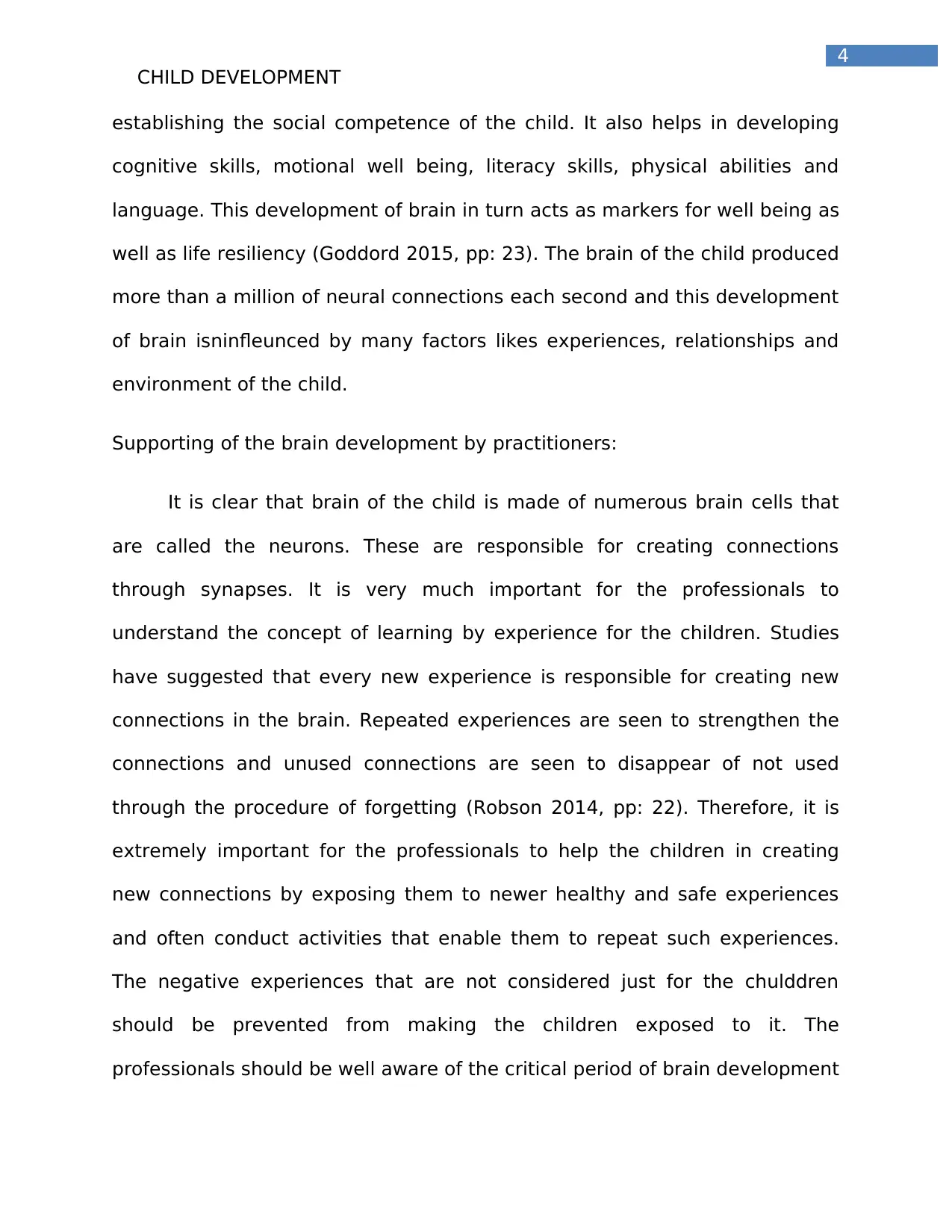
4
CHILD DEVELOPMENT
establishing the social competence of the child. It also helps in developing
cognitive skills, motional well being, literacy skills, physical abilities and
language. This development of brain in turn acts as markers for well being as
well as life resiliency (Goddord 2015, pp: 23). The brain of the child produced
more than a million of neural connections each second and this development
of brain isninfleunced by many factors likes experiences, relationships and
environment of the child.
Supporting of the brain development by practitioners:
It is clear that brain of the child is made of numerous brain cells that
are called the neurons. These are responsible for creating connections
through synapses. It is very much important for the professionals to
understand the concept of learning by experience for the children. Studies
have suggested that every new experience is responsible for creating new
connections in the brain. Repeated experiences are seen to strengthen the
connections and unused connections are seen to disappear of not used
through the procedure of forgetting (Robson 2014, pp: 22). Therefore, it is
extremely important for the professionals to help the children in creating
new connections by exposing them to newer healthy and safe experiences
and often conduct activities that enable them to repeat such experiences.
The negative experiences that are not considered just for the chulddren
should be prevented from making the children exposed to it. The
professionals should be well aware of the critical period of brain development
CHILD DEVELOPMENT
establishing the social competence of the child. It also helps in developing
cognitive skills, motional well being, literacy skills, physical abilities and
language. This development of brain in turn acts as markers for well being as
well as life resiliency (Goddord 2015, pp: 23). The brain of the child produced
more than a million of neural connections each second and this development
of brain isninfleunced by many factors likes experiences, relationships and
environment of the child.
Supporting of the brain development by practitioners:
It is clear that brain of the child is made of numerous brain cells that
are called the neurons. These are responsible for creating connections
through synapses. It is very much important for the professionals to
understand the concept of learning by experience for the children. Studies
have suggested that every new experience is responsible for creating new
connections in the brain. Repeated experiences are seen to strengthen the
connections and unused connections are seen to disappear of not used
through the procedure of forgetting (Robson 2014, pp: 22). Therefore, it is
extremely important for the professionals to help the children in creating
new connections by exposing them to newer healthy and safe experiences
and often conduct activities that enable them to repeat such experiences.
The negative experiences that are not considered just for the chulddren
should be prevented from making the children exposed to it. The
professionals should be well aware of the critical period of brain development

5
CHILD DEVELOPMENT
of the child that occurs during childhood and to some extent in the
adolescent period (Genessar 2018, pp: 37). Researchers are of the opinion
that formation of the new neurons and synapses is the fastest at birth and
they gradually begin to slower over time. Therefore, babies and toddlers
learn fast compared to adults and these situation should be used with proper
planning and better expectations and good experiences by the professionals
so that the child brain develops well. Researchers suggest that play is a
wonderful way of helping the baby as well as toddler for development of the
brain (Popeska 2016, pp: 89). Babies feel stressed and therefore comforting,
cuddling and making them feel loved ensure better development of the
baby. Reading is another way of promoting the brain of the child/ foe ample,
it is found that hearing words and thereby seeing pictures help in connecting
the two in the mind of the child. Even before he or she recognizes letters or
words, reading is mainly seen to kick-start communication as well as
language skills (Karmiloff 2018, pp: 69).
Piaget’s cognitive developmental theory:
This theory is said to be concerned with the developmental procedures
of the thought processes of the person. This also helps in looking at how
these thought processes helps in influencing how individuals understand and
thereby interact with the surrounding environment. It was the famous
researcher Piaget, who had put forward an important concept (Osherson
2017, pp 229) . This might seem obvious in present days but had helped in
CHILD DEVELOPMENT
of the child that occurs during childhood and to some extent in the
adolescent period (Genessar 2018, pp: 37). Researchers are of the opinion
that formation of the new neurons and synapses is the fastest at birth and
they gradually begin to slower over time. Therefore, babies and toddlers
learn fast compared to adults and these situation should be used with proper
planning and better expectations and good experiences by the professionals
so that the child brain develops well. Researchers suggest that play is a
wonderful way of helping the baby as well as toddler for development of the
brain (Popeska 2016, pp: 89). Babies feel stressed and therefore comforting,
cuddling and making them feel loved ensure better development of the
baby. Reading is another way of promoting the brain of the child/ foe ample,
it is found that hearing words and thereby seeing pictures help in connecting
the two in the mind of the child. Even before he or she recognizes letters or
words, reading is mainly seen to kick-start communication as well as
language skills (Karmiloff 2018, pp: 69).
Piaget’s cognitive developmental theory:
This theory is said to be concerned with the developmental procedures
of the thought processes of the person. This also helps in looking at how
these thought processes helps in influencing how individuals understand and
thereby interact with the surrounding environment. It was the famous
researcher Piaget, who had put forward an important concept (Osherson
2017, pp 229) . This might seem obvious in present days but had helped in
⊘ This is a preview!⊘
Do you want full access?
Subscribe today to unlock all pages.

Trusted by 1+ million students worldwide
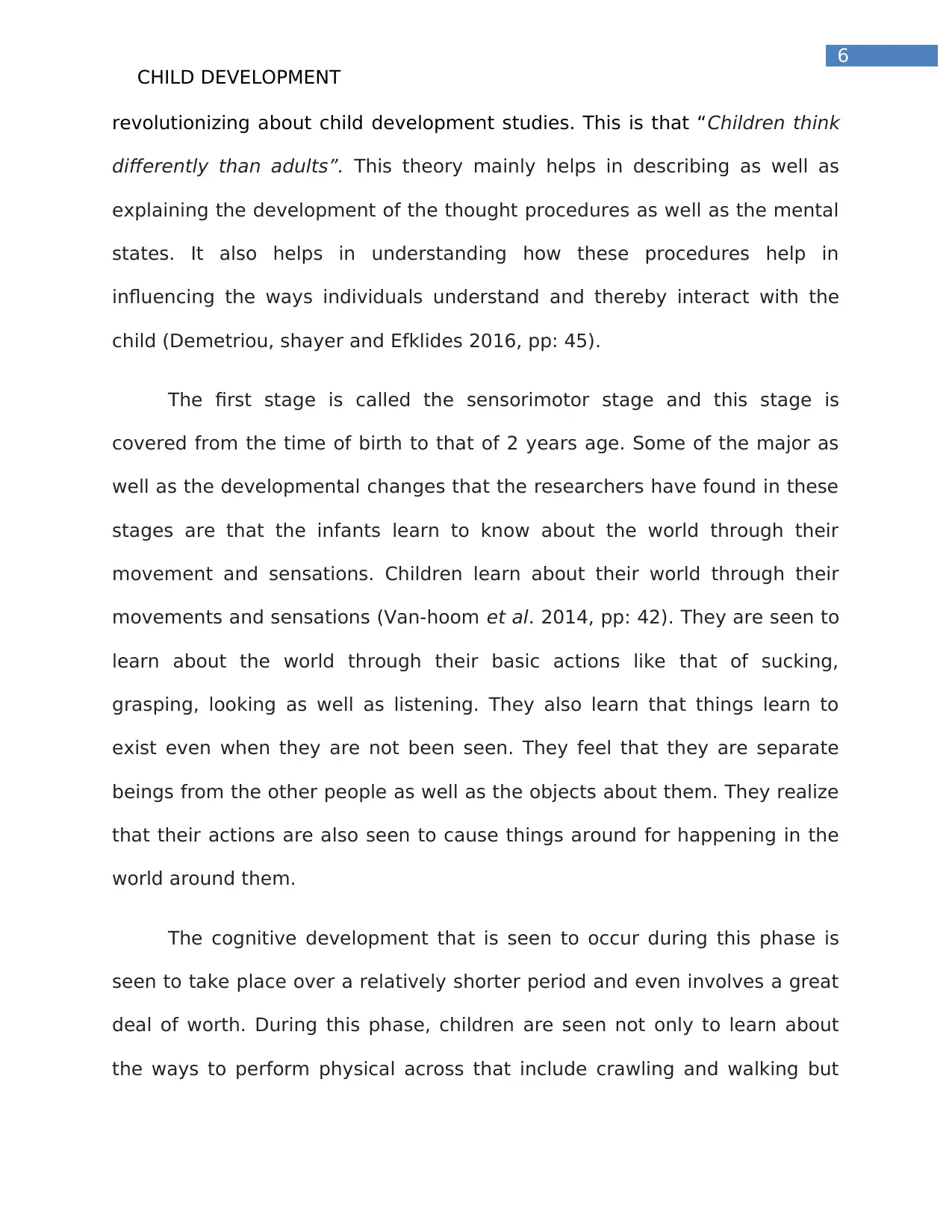
6
CHILD DEVELOPMENT
revolutionizing about child development studies. This is that “Children think
differently than adults”. This theory mainly helps in describing as well as
explaining the development of the thought procedures as well as the mental
states. It also helps in understanding how these procedures help in
influencing the ways individuals understand and thereby interact with the
child (Demetriou, shayer and Efklides 2016, pp: 45).
The first stage is called the sensorimotor stage and this stage is
covered from the time of birth to that of 2 years age. Some of the major as
well as the developmental changes that the researchers have found in these
stages are that the infants learn to know about the world through their
movement and sensations. Children learn about their world through their
movements and sensations (Van-hoom et al. 2014, pp: 42). They are seen to
learn about the world through their basic actions like that of sucking,
grasping, looking as well as listening. They also learn that things learn to
exist even when they are not been seen. They feel that they are separate
beings from the other people as well as the objects about them. They realize
that their actions are also seen to cause things around for happening in the
world around them.
The cognitive development that is seen to occur during this phase is
seen to take place over a relatively shorter period and even involves a great
deal of worth. During this phase, children are seen not only to learn about
the ways to perform physical across that include crawling and walking but
CHILD DEVELOPMENT
revolutionizing about child development studies. This is that “Children think
differently than adults”. This theory mainly helps in describing as well as
explaining the development of the thought procedures as well as the mental
states. It also helps in understanding how these procedures help in
influencing the ways individuals understand and thereby interact with the
child (Demetriou, shayer and Efklides 2016, pp: 45).
The first stage is called the sensorimotor stage and this stage is
covered from the time of birth to that of 2 years age. Some of the major as
well as the developmental changes that the researchers have found in these
stages are that the infants learn to know about the world through their
movement and sensations. Children learn about their world through their
movements and sensations (Van-hoom et al. 2014, pp: 42). They are seen to
learn about the world through their basic actions like that of sucking,
grasping, looking as well as listening. They also learn that things learn to
exist even when they are not been seen. They feel that they are separate
beings from the other people as well as the objects about them. They realize
that their actions are also seen to cause things around for happening in the
world around them.
The cognitive development that is seen to occur during this phase is
seen to take place over a relatively shorter period and even involves a great
deal of worth. During this phase, children are seen not only to learn about
the ways to perform physical across that include crawling and walking but
Paraphrase This Document
Need a fresh take? Get an instant paraphrase of this document with our AI Paraphraser
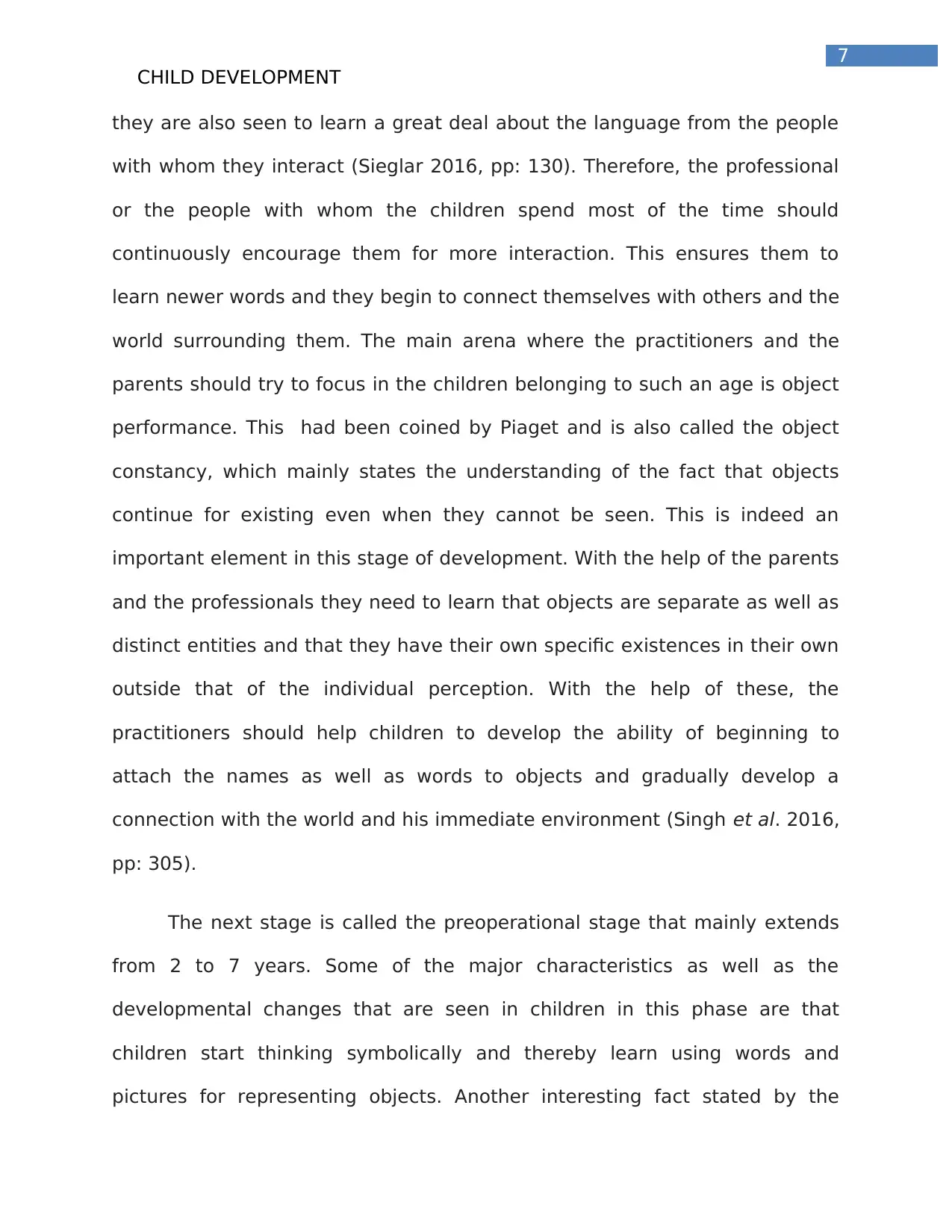
7
CHILD DEVELOPMENT
they are also seen to learn a great deal about the language from the people
with whom they interact (Sieglar 2016, pp: 130). Therefore, the professional
or the people with whom the children spend most of the time should
continuously encourage them for more interaction. This ensures them to
learn newer words and they begin to connect themselves with others and the
world surrounding them. The main arena where the practitioners and the
parents should try to focus in the children belonging to such an age is object
performance. This had been coined by Piaget and is also called the object
constancy, which mainly states the understanding of the fact that objects
continue for existing even when they cannot be seen. This is indeed an
important element in this stage of development. With the help of the parents
and the professionals they need to learn that objects are separate as well as
distinct entities and that they have their own specific existences in their own
outside that of the individual perception. With the help of these, the
practitioners should help children to develop the ability of beginning to
attach the names as well as words to objects and gradually develop a
connection with the world and his immediate environment (Singh et al. 2016,
pp: 305).
The next stage is called the preoperational stage that mainly extends
from 2 to 7 years. Some of the major characteristics as well as the
developmental changes that are seen in children in this phase are that
children start thinking symbolically and thereby learn using words and
pictures for representing objects. Another interesting fact stated by the
CHILD DEVELOPMENT
they are also seen to learn a great deal about the language from the people
with whom they interact (Sieglar 2016, pp: 130). Therefore, the professional
or the people with whom the children spend most of the time should
continuously encourage them for more interaction. This ensures them to
learn newer words and they begin to connect themselves with others and the
world surrounding them. The main arena where the practitioners and the
parents should try to focus in the children belonging to such an age is object
performance. This had been coined by Piaget and is also called the object
constancy, which mainly states the understanding of the fact that objects
continue for existing even when they cannot be seen. This is indeed an
important element in this stage of development. With the help of the parents
and the professionals they need to learn that objects are separate as well as
distinct entities and that they have their own specific existences in their own
outside that of the individual perception. With the help of these, the
practitioners should help children to develop the ability of beginning to
attach the names as well as words to objects and gradually develop a
connection with the world and his immediate environment (Singh et al. 2016,
pp: 305).
The next stage is called the preoperational stage that mainly extends
from 2 to 7 years. Some of the major characteristics as well as the
developmental changes that are seen in children in this phase are that
children start thinking symbolically and thereby learn using words and
pictures for representing objects. Another interesting fact stated by the
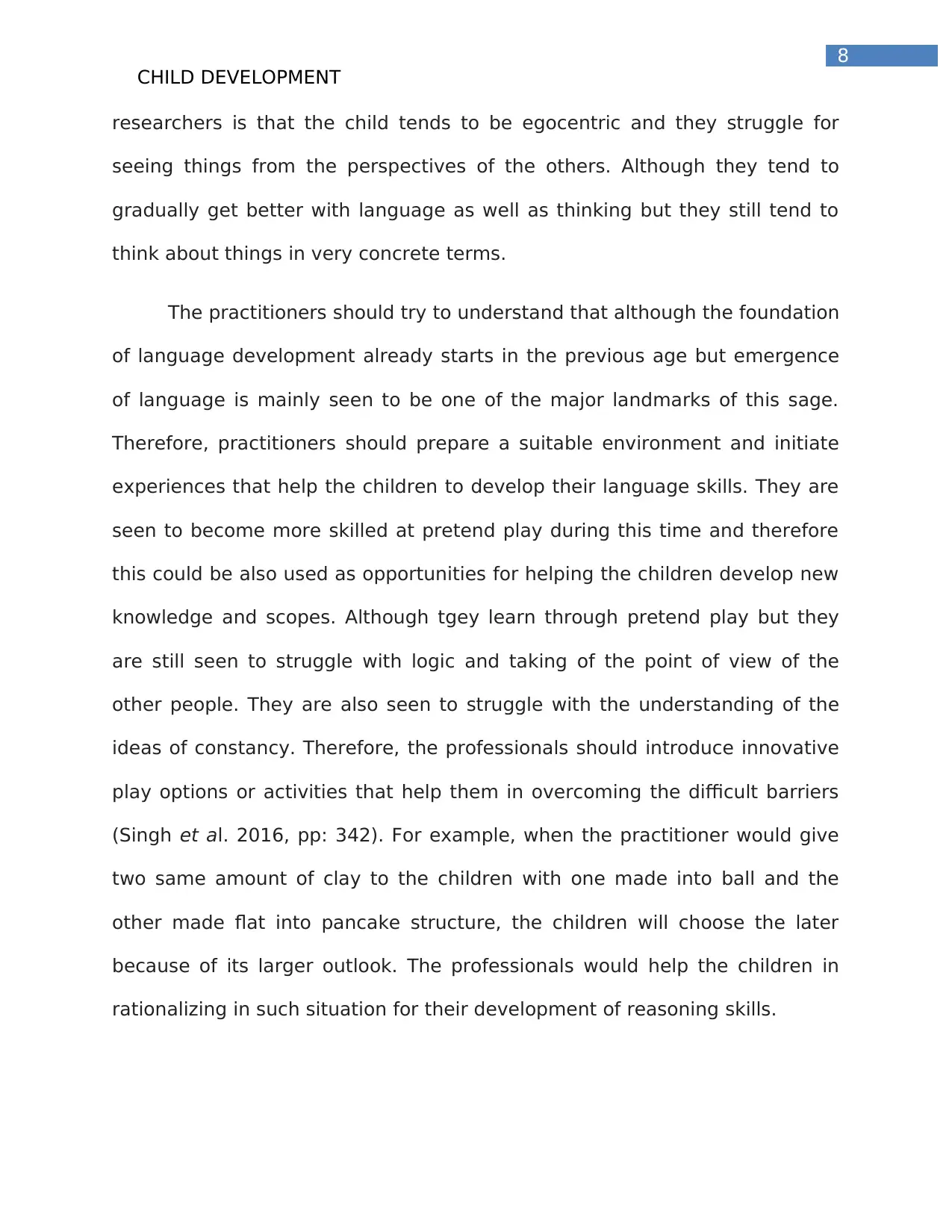
8
CHILD DEVELOPMENT
researchers is that the child tends to be egocentric and they struggle for
seeing things from the perspectives of the others. Although they tend to
gradually get better with language as well as thinking but they still tend to
think about things in very concrete terms.
The practitioners should try to understand that although the foundation
of language development already starts in the previous age but emergence
of language is mainly seen to be one of the major landmarks of this sage.
Therefore, practitioners should prepare a suitable environment and initiate
experiences that help the children to develop their language skills. They are
seen to become more skilled at pretend play during this time and therefore
this could be also used as opportunities for helping the children develop new
knowledge and scopes. Although tgey learn through pretend play but they
are still seen to struggle with logic and taking of the point of view of the
other people. They are also seen to struggle with the understanding of the
ideas of constancy. Therefore, the professionals should introduce innovative
play options or activities that help them in overcoming the difficult barriers
(Singh et al. 2016, pp: 342). For example, when the practitioner would give
two same amount of clay to the children with one made into ball and the
other made flat into pancake structure, the children will choose the later
because of its larger outlook. The professionals would help the children in
rationalizing in such situation for their development of reasoning skills.
CHILD DEVELOPMENT
researchers is that the child tends to be egocentric and they struggle for
seeing things from the perspectives of the others. Although they tend to
gradually get better with language as well as thinking but they still tend to
think about things in very concrete terms.
The practitioners should try to understand that although the foundation
of language development already starts in the previous age but emergence
of language is mainly seen to be one of the major landmarks of this sage.
Therefore, practitioners should prepare a suitable environment and initiate
experiences that help the children to develop their language skills. They are
seen to become more skilled at pretend play during this time and therefore
this could be also used as opportunities for helping the children develop new
knowledge and scopes. Although tgey learn through pretend play but they
are still seen to struggle with logic and taking of the point of view of the
other people. They are also seen to struggle with the understanding of the
ideas of constancy. Therefore, the professionals should introduce innovative
play options or activities that help them in overcoming the difficult barriers
(Singh et al. 2016, pp: 342). For example, when the practitioner would give
two same amount of clay to the children with one made into ball and the
other made flat into pancake structure, the children will choose the later
because of its larger outlook. The professionals would help the children in
rationalizing in such situation for their development of reasoning skills.
⊘ This is a preview!⊘
Do you want full access?
Subscribe today to unlock all pages.

Trusted by 1+ million students worldwide
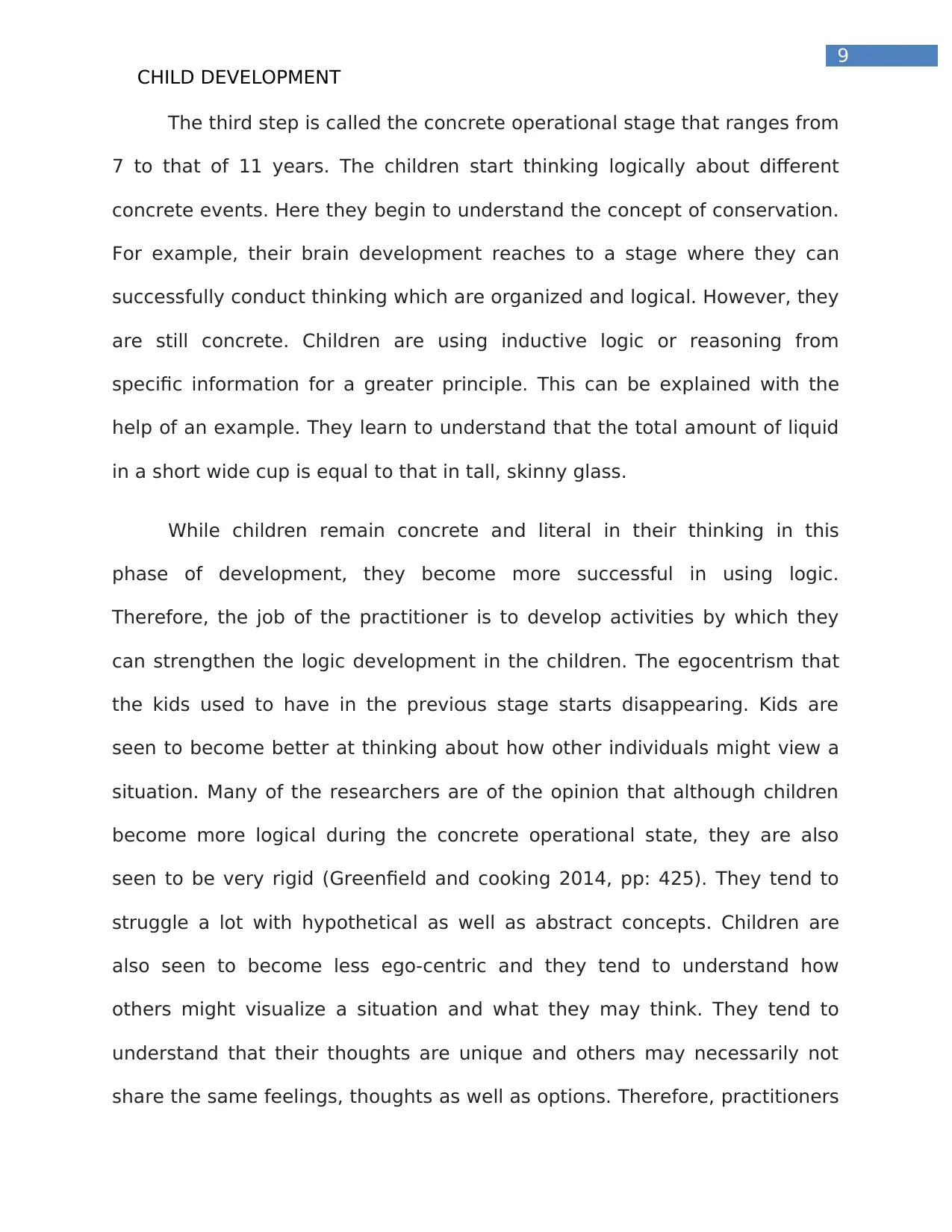
9
CHILD DEVELOPMENT
The third step is called the concrete operational stage that ranges from
7 to that of 11 years. The children start thinking logically about different
concrete events. Here they begin to understand the concept of conservation.
For example, their brain development reaches to a stage where they can
successfully conduct thinking which are organized and logical. However, they
are still concrete. Children are using inductive logic or reasoning from
specific information for a greater principle. This can be explained with the
help of an example. They learn to understand that the total amount of liquid
in a short wide cup is equal to that in tall, skinny glass.
While children remain concrete and literal in their thinking in this
phase of development, they become more successful in using logic.
Therefore, the job of the practitioner is to develop activities by which they
can strengthen the logic development in the children. The egocentrism that
the kids used to have in the previous stage starts disappearing. Kids are
seen to become better at thinking about how other individuals might view a
situation. Many of the researchers are of the opinion that although children
become more logical during the concrete operational state, they are also
seen to be very rigid (Greenfield and cooking 2014, pp: 425). They tend to
struggle a lot with hypothetical as well as abstract concepts. Children are
also seen to become less ego-centric and they tend to understand how
others might visualize a situation and what they may think. They tend to
understand that their thoughts are unique and others may necessarily not
share the same feelings, thoughts as well as options. Therefore, practitioners
CHILD DEVELOPMENT
The third step is called the concrete operational stage that ranges from
7 to that of 11 years. The children start thinking logically about different
concrete events. Here they begin to understand the concept of conservation.
For example, their brain development reaches to a stage where they can
successfully conduct thinking which are organized and logical. However, they
are still concrete. Children are using inductive logic or reasoning from
specific information for a greater principle. This can be explained with the
help of an example. They learn to understand that the total amount of liquid
in a short wide cup is equal to that in tall, skinny glass.
While children remain concrete and literal in their thinking in this
phase of development, they become more successful in using logic.
Therefore, the job of the practitioner is to develop activities by which they
can strengthen the logic development in the children. The egocentrism that
the kids used to have in the previous stage starts disappearing. Kids are
seen to become better at thinking about how other individuals might view a
situation. Many of the researchers are of the opinion that although children
become more logical during the concrete operational state, they are also
seen to be very rigid (Greenfield and cooking 2014, pp: 425). They tend to
struggle a lot with hypothetical as well as abstract concepts. Children are
also seen to become less ego-centric and they tend to understand how
others might visualize a situation and what they may think. They tend to
understand that their thoughts are unique and others may necessarily not
share the same feelings, thoughts as well as options. Therefore, practitioners
Paraphrase This Document
Need a fresh take? Get an instant paraphrase of this document with our AI Paraphraser
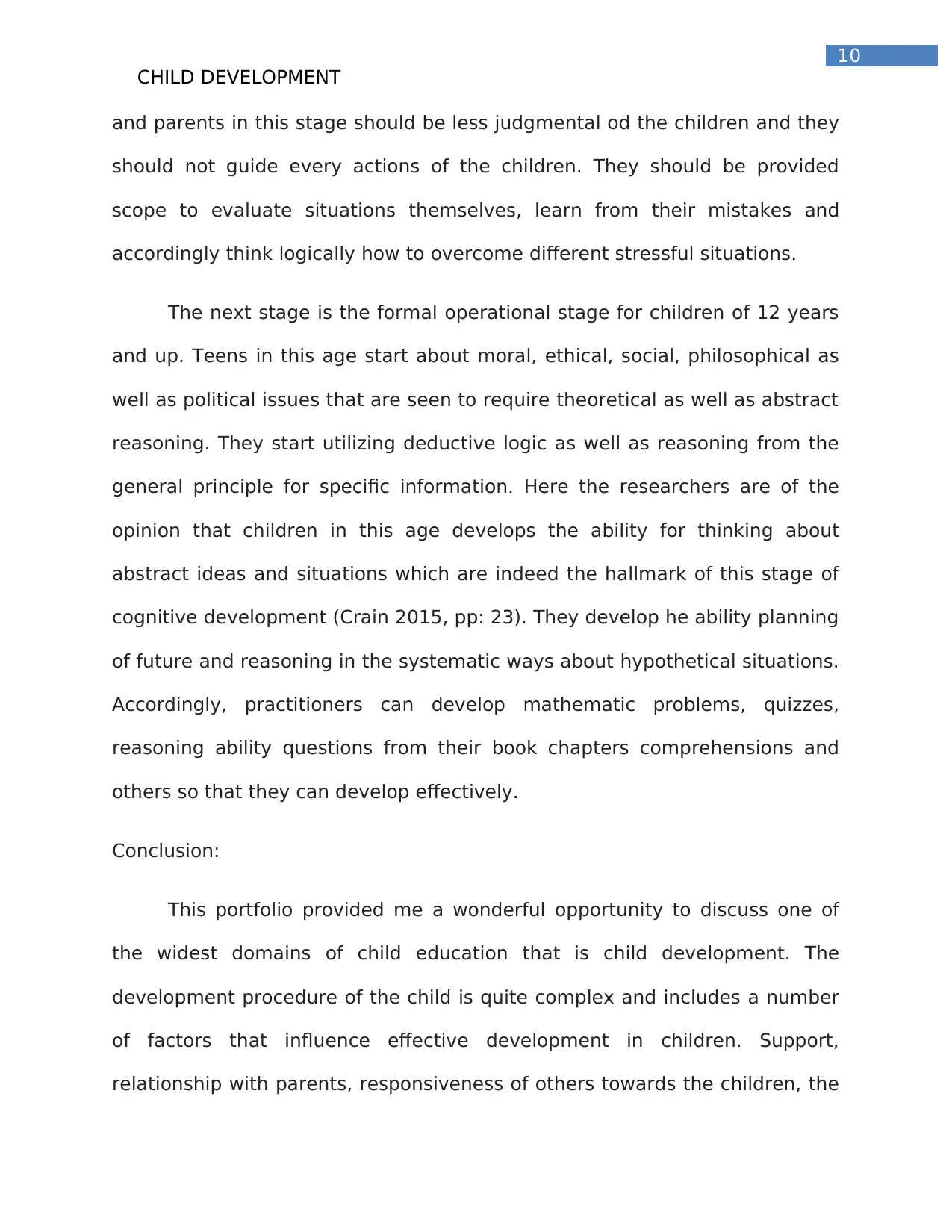
10
CHILD DEVELOPMENT
and parents in this stage should be less judgmental od the children and they
should not guide every actions of the children. They should be provided
scope to evaluate situations themselves, learn from their mistakes and
accordingly think logically how to overcome different stressful situations.
The next stage is the formal operational stage for children of 12 years
and up. Teens in this age start about moral, ethical, social, philosophical as
well as political issues that are seen to require theoretical as well as abstract
reasoning. They start utilizing deductive logic as well as reasoning from the
general principle for specific information. Here the researchers are of the
opinion that children in this age develops the ability for thinking about
abstract ideas and situations which are indeed the hallmark of this stage of
cognitive development (Crain 2015, pp: 23). They develop he ability planning
of future and reasoning in the systematic ways about hypothetical situations.
Accordingly, practitioners can develop mathematic problems, quizzes,
reasoning ability questions from their book chapters comprehensions and
others so that they can develop effectively.
Conclusion:
This portfolio provided me a wonderful opportunity to discuss one of
the widest domains of child education that is child development. The
development procedure of the child is quite complex and includes a number
of factors that influence effective development in children. Support,
relationship with parents, responsiveness of others towards the children, the
CHILD DEVELOPMENT
and parents in this stage should be less judgmental od the children and they
should not guide every actions of the children. They should be provided
scope to evaluate situations themselves, learn from their mistakes and
accordingly think logically how to overcome different stressful situations.
The next stage is the formal operational stage for children of 12 years
and up. Teens in this age start about moral, ethical, social, philosophical as
well as political issues that are seen to require theoretical as well as abstract
reasoning. They start utilizing deductive logic as well as reasoning from the
general principle for specific information. Here the researchers are of the
opinion that children in this age develops the ability for thinking about
abstract ideas and situations which are indeed the hallmark of this stage of
cognitive development (Crain 2015, pp: 23). They develop he ability planning
of future and reasoning in the systematic ways about hypothetical situations.
Accordingly, practitioners can develop mathematic problems, quizzes,
reasoning ability questions from their book chapters comprehensions and
others so that they can develop effectively.
Conclusion:
This portfolio provided me a wonderful opportunity to discuss one of
the widest domains of child education that is child development. The
development procedure of the child is quite complex and includes a number
of factors that influence effective development in children. Support,
relationship with parents, responsiveness of others towards the children, the
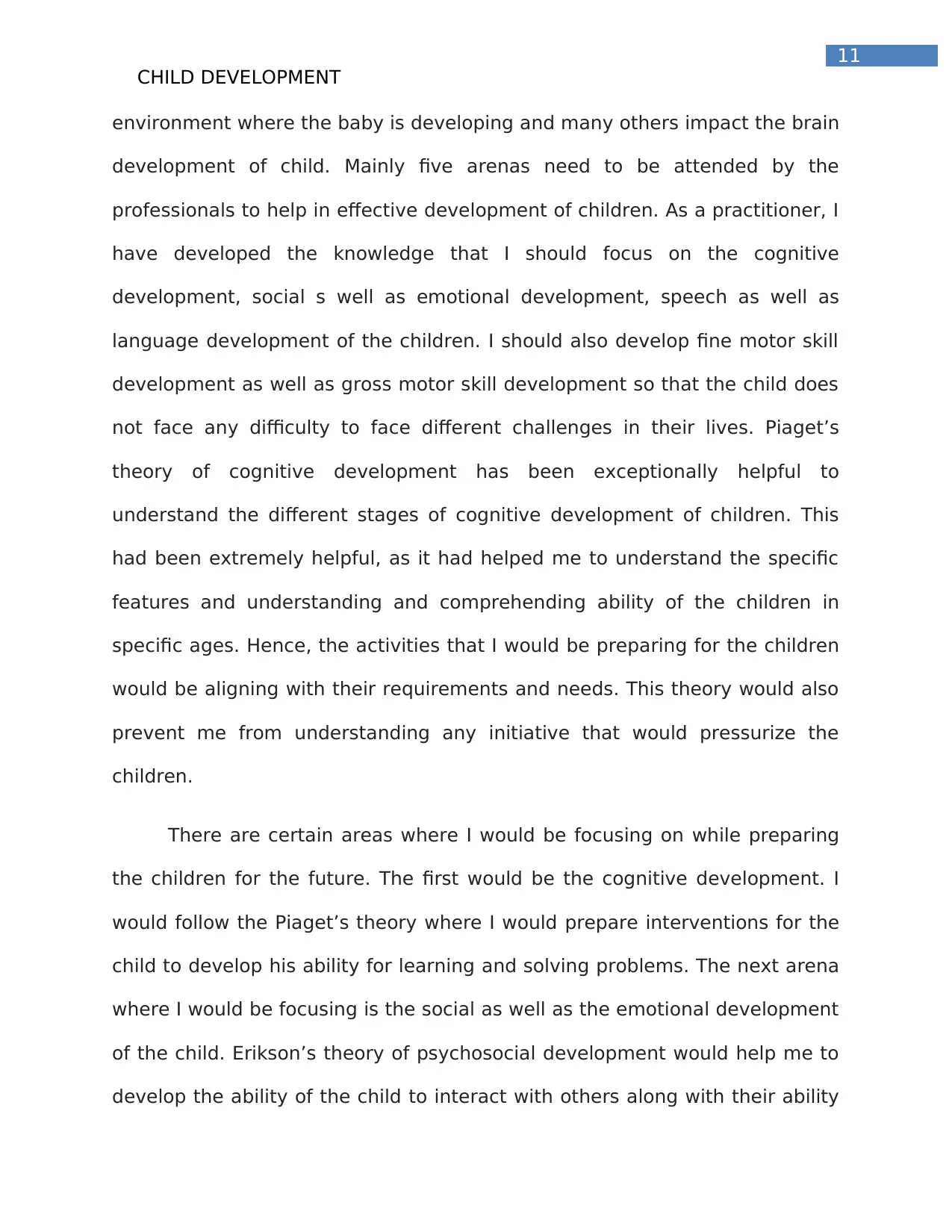
11
CHILD DEVELOPMENT
environment where the baby is developing and many others impact the brain
development of child. Mainly five arenas need to be attended by the
professionals to help in effective development of children. As a practitioner, I
have developed the knowledge that I should focus on the cognitive
development, social s well as emotional development, speech as well as
language development of the children. I should also develop fine motor skill
development as well as gross motor skill development so that the child does
not face any difficulty to face different challenges in their lives. Piaget’s
theory of cognitive development has been exceptionally helpful to
understand the different stages of cognitive development of children. This
had been extremely helpful, as it had helped me to understand the specific
features and understanding and comprehending ability of the children in
specific ages. Hence, the activities that I would be preparing for the children
would be aligning with their requirements and needs. This theory would also
prevent me from understanding any initiative that would pressurize the
children.
There are certain areas where I would be focusing on while preparing
the children for the future. The first would be the cognitive development. I
would follow the Piaget’s theory where I would prepare interventions for the
child to develop his ability for learning and solving problems. The next arena
where I would be focusing is the social as well as the emotional development
of the child. Erikson’s theory of psychosocial development would help me to
develop the ability of the child to interact with others along with their ability
CHILD DEVELOPMENT
environment where the baby is developing and many others impact the brain
development of child. Mainly five arenas need to be attended by the
professionals to help in effective development of children. As a practitioner, I
have developed the knowledge that I should focus on the cognitive
development, social s well as emotional development, speech as well as
language development of the children. I should also develop fine motor skill
development as well as gross motor skill development so that the child does
not face any difficulty to face different challenges in their lives. Piaget’s
theory of cognitive development has been exceptionally helpful to
understand the different stages of cognitive development of children. This
had been extremely helpful, as it had helped me to understand the specific
features and understanding and comprehending ability of the children in
specific ages. Hence, the activities that I would be preparing for the children
would be aligning with their requirements and needs. This theory would also
prevent me from understanding any initiative that would pressurize the
children.
There are certain areas where I would be focusing on while preparing
the children for the future. The first would be the cognitive development. I
would follow the Piaget’s theory where I would prepare interventions for the
child to develop his ability for learning and solving problems. The next arena
where I would be focusing is the social as well as the emotional development
of the child. Erikson’s theory of psychosocial development would help me to
develop the ability of the child to interact with others along with their ability
⊘ This is a preview!⊘
Do you want full access?
Subscribe today to unlock all pages.

Trusted by 1+ million students worldwide
1 out of 16
Related Documents
Your All-in-One AI-Powered Toolkit for Academic Success.
+13062052269
info@desklib.com
Available 24*7 on WhatsApp / Email
![[object Object]](/_next/static/media/star-bottom.7253800d.svg)
Unlock your academic potential
Copyright © 2020–2025 A2Z Services. All Rights Reserved. Developed and managed by ZUCOL.





